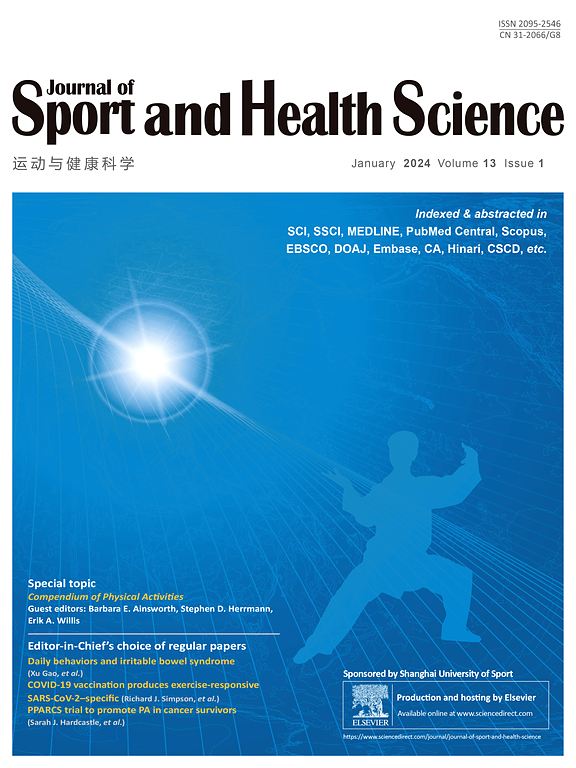长期有氧运动增强循环外泌体miR-214-3p促进内皮祖细胞介导的肥胖引起的内皮损伤修复。
IF 10.3
1区 医学
Q1 HOSPITALITY, LEISURE, SPORT & TOURISM
引用次数: 0
摘要
运动训练可以通过增强内皮祖细胞(EPC)的修复能力来抵消肥胖对内皮功能的有害影响;然而,运动诱导的内皮细胞介导的内皮修复的潜在机制尚不清楚。本研究旨在确定运动诱导的循环外泌体防止肥胖引起的内皮功能障碍的机制。方法对肥胖受试者和高脂饮食诱导的肥胖大鼠进行为期8周的有氧运动干预。分离循环外泌体并进行表征。microRNA测序、分子生物学技术和功能测定(包括增殖、迁移和荧光素酶报告基因测定)被用于鉴定关键的外泌体microRNA及其下游靶点。采用microRNA-214-3p (miR-214-3p)敲除大鼠模型验证其在体内的作用。结果:在肥胖的人和大鼠中,运动促进了epc介导的内皮损伤修复和外泌体miR-214-3p的上调,而外泌体的数量没有改变。miR-214-3p通过上调I型胶原α -2链(COL1A2)的表达,直接促进EPC增殖和迁移,并通过磷酸酶和紧张素同源物磷脂酰肌醇3-激酶,丝氨酸/苏氨酸激酶(PTEN-PI3K-Akt)信号通路间接促进EPC增殖和迁移。敲除miR-214-3p消除了运动引起的内皮和EPC功能的改善。心肌被认为是运动诱导的循环外泌体miR-214-3p升高的重要来源。结论长期有氧运动通过富集循环外泌体miR-214-3p促进肥胖的内皮细胞修复,从而通过PTEN-PI3K-Akt通路和直接调节COL1A2增强EPC功能。这些发现揭示了一种新的外泌体介导的机制,通过这种机制,运动可以改善血管健康,并为肥胖相关的内皮功能障碍提供了潜在的治疗策略。本文章由计算机程序翻译,如有差异,请以英文原文为准。
Long-term aerobic exercise enhances circulating exosomal miR-214-3p to promote endothelial progenitor cell-mediated repair of endothelial damage induced by obesity.
BACKGROUND
Exercise training may counteract the detrimental effects of obesity on endothelial function by enhancing the reparative capabilities of endothelial progenitor cells (EPC); however, the underlying mechanisms of exercise-induced EPC-mediated endothelial repair are still unclear. The present study aimed to determine the mechanisms by which exercise-induced circulating exosomes protect against endothelial dysfunction induced by obesity.
METHODS
An 8-week aerobic exercise intervention in both obese human participants and high-fat diet-induced obese rats was conducted. Circulating exosomes were isolated and characterized. microRNA sequencing, molecular biology techniques, and functional assays (including proliferation, migration, and luciferase reporter assays) were employed to identify key exosomal microRNAs and their downstream targets. A microRNA-214-3p (miR-214-3p) knockout rat model was used to validate its role in vivo.
RESULTS
Exercise promoted EPC-mediated repair of endothelial damage and upregulated exosomal miR-214-3p in both obese humans and rats, without altering exosome quantity. miR-214-3p enhanced EPC proliferation and migration directly, by upregulating collagen type I alpha 2 chain (COL1A2) expression, and indirectly, through the phosphatase and tensin homolog, phosphatidylinositol 3-kinase, serine/threonine kinase (PTEN-PI3K-Akt) signaling pathway. Knockout of miR-214-3p abolished the exercise-induced improvements in endothelial and EPC functionalities. The myocardium was identified as an important source of the exercise-induced increase in circulating exosomal miR-214-3p.
CONCLUSION
Long-term aerobic exercise promotes endothelial repair in obesity by enriching circulating exosomes with miR-214-3p, which enhances EPC function via the PTEN-PI3K-Akt pathway and direct regulation of COL1A2. These findings reveal a novel exosome-mediated mechanism through which exercise improves vascular health and suggest potential therapeutic strategies for obesity-related endothelial dysfunction.
求助全文
通过发布文献求助,成功后即可免费获取论文全文。
去求助
来源期刊

Journal of Sport and Health Science
SPORT SCIENCES-
CiteScore
18.30
自引率
1.70%
发文量
101
审稿时长
22 weeks
期刊介绍:
The Journal of Sport and Health Science (JSHS) is an international, multidisciplinary journal that aims to advance the fields of sport, exercise, physical activity, and health sciences. Published by Elsevier B.V. on behalf of Shanghai University of Sport, JSHS is dedicated to promoting original and impactful research, as well as topical reviews, editorials, opinions, and commentary papers.
With a focus on physical and mental health, injury and disease prevention, traditional Chinese exercise, and human performance, JSHS offers a platform for scholars and researchers to share their findings and contribute to the advancement of these fields. Our journal is peer-reviewed, ensuring that all published works meet the highest academic standards.
Supported by a carefully selected international editorial board, JSHS upholds impeccable integrity and provides an efficient publication platform. We invite submissions from scholars and researchers worldwide, and we are committed to disseminating insightful and influential research in the field of sport and health science.
 求助内容:
求助内容: 应助结果提醒方式:
应助结果提醒方式:


